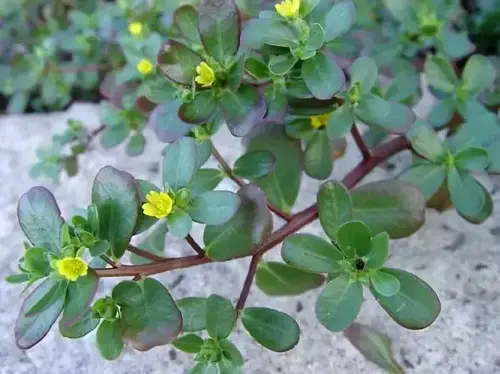Purslane, pennywort, amaranth… do not need much fertilization but still grow green and lush, both as food and medicine.
Coil Vietnamese medicinal plants and herbs by Professor Do Tat Loi provides a lot of interesting information about the effects of plants around us. Below are 5 types of wild vegetables or very easy to grow that can be used as medicine, note that you need to consult a doctor of Oriental medicine before using:
purslane Also known as purslane, it belongs to the purslane family and grows wild in humid places in both Europe and Asia. It is rarely grown at home. The plant has a sour taste, cold properties, and is not toxic. It affects three meridians: heart, liver, and spleen. Warning: People with weak spleen and stomach, cold, and diarrhea should not use it.

Purslane often grows wild in wet places. Illustration: Indiabiodiversity
Purslane contains many vitamins A, B, C and a variety of micronutrients that are good for health. This vegetable has the effect of constricting blood vessels, inhibiting the growth of dysentery bacteria, typhoid bacteria, and E.coli bacteria. Vietnamese people also crush purslane to apply on boils, as a diuretic, and to remove pinworms.
Lettuce fish Also known as giếp lá, ngư tinh thảo, belongs to the giếp family. This plant prefers humid places, has heart-shaped leaves, and is often picked and eaten with fish. The plant can be used fresh or dried. Fish mint has a diuretic effect due to the presence of quercetin and inorganic substances.
According to Oriental medicine, the plant has a spicy, slightly cold, slightly toxic taste; it has the effect of dispersing heat, eliminating perforations, and is used to treat lung cancer, hemorrhoids, and ulcers. People use fish mint in cases of blood clots (crushing the leaves, pressing them on paper and applying) or hemorrhoids (boiling the water to drink, boiling the water to take the steam and then washing). In addition, fish mint also has the effect of promoting urination, treating boils, and irregular menstruation.
Amaranth Contains many nutrients, such as vitamin C, B1, B2, vitamin PP, carotene, ethylcholesterol compounds, dehydrocholesterol... Amaranth leaves and young branches cooked in soup have anti-inflammatory, detoxifying effects; treat acne and dysentery. Amaranth seeds have a sweet taste, cold properties, cool the liver, clear heat, benefit qi, and brighten eyes. Medicines often use amaranth seeds to make a drink.
Amaranth bark is used to treat irregular menstruation and anemia. Amaranth leaves are used to treat pain and rheumatism. Powdered or soaked in alcohol, the bark is used as a tonic and to treat malaria.
Pennywort Also known as tich tuyet thao, lien tien thao, belonging to the Apiaceae family. The plant grows wild in tropical countries including Vietnam. When fresh, the plant has a bitter, slightly unpleasant taste, and can be harvested year-round. According to Oriental medicine, gotu kola is neutral, non-toxic, cooling, detoxifying, diuretic, used to treat hemoptysis, diarrhea, vaginal discharge, and lactation, and can be used in combination with knotweed to stop bleeding. Medicines often use fresh leaves, crushed, and the juice to drink.
Wormwood also known as medicine, ointment, mugwort, wormwood, belongs to the daisy family. The plant grows wild in many places.
Mugwort contains essential oils, tannins, adenine, and choline. According to Oriental medicine, this is a warm, spicy medicine used to warm the blood, regulate menstruation, stabilize pregnancy, treat abdominal pain due to cold, irregular menstruation, restless fetus, hemoptysis, and nosebleeds. In addition, mugwort is also used as a medicine to treat digestive disorders, abdominal pain, vomiting, worms, and malaria. People can boil mugwort with water, steep it in boiling water, or drink it in powder or concentrated form.
Sources: https://giadinh.suckhoedoisong.vn/top-5-loai-rau-moc-dau-cung-tot-duoc-luong-y-dung-lam-thuoc-172241106205837663.htm
